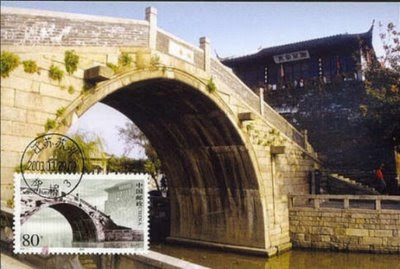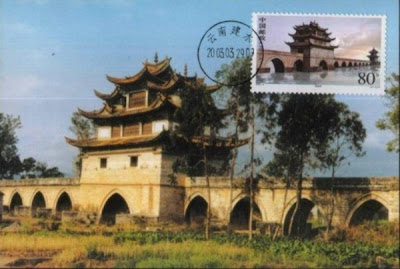1) Yangmingshan Hot Springs (NT$5): Most hot springs here are sulfur springs, with a temperature ranging between 60° to 70°C. This water is for bathing only. Approach Yangmingshan through Yangde Boulevard and then take the Yang-Jin Highway. Along the highway, many signs indicate previous volcanic activity. The landscapes of Siaoyoukeng and Sulfur Valley fumaroles are the spots that are well worth a stop. A picture of these fumaroles is found in the teardrop-shaped window on the upper left corner of the stamp.
2) Suao Cold Springs (NT$5): It rains a lot in the Suao area, and rainwater percolates down into the earth’s crust to a depth of about 2,000 meters, reaching cracks in the slate. Then, as a result of tectonic movement, the carbonate content in the rocks dissolves and releases a large amount of carbon dioxide, making the underground water bubbly and pushing it to the surface in the form of carbonated cold springs. The springs here are used for drinking as well as bathing. The temperature of the water is about 22°C. The design of the stamp includes Cold Springs Park and Nanfangao Bridge.
Nanfangao Bridge was inaugurated in June, 1998. The bridge connects Su-Ao Port and Nan-Fang-Ao. The single-arch suspension bridge has special fish, shrimp and crab designs on the bridge column that symbolize the ocean. There is also a landscape platform for tourists to overlook vessels in and out of the fishing port.
3) Guanziling Murky Hot Springs (NT$10): The rising spring water here brings minerals, salt and mud particles with them when it goes through the mudstone layers below the surface, making the spring water look murky and even black. Therefore, it is also known in Chinese as the Black Hot Spring. This is an alkaline carbonate spring, of a temperature about 75°C. This water is for bathing only. Featured in the teardrop-shaped window on the upper left corner of the stamp is a photo of the famous ShueiHuoTongYuan (which means “where water and fire spring from the same source”). The reason for this spectacular phenomenon is that spring water and natural gas are both coming out of the cliff surface at Mt. Jhentou, so that when the gas is lit, you get water and fire together.
4) Green Island Seabed Hot Springs (NT$25): The hot springs here rise out of groups of rocks and reefs along the shore. The temperature of these acidic sulfur springs ranges between 53° to 93°C. The water has a high salt content and is undrinkable. The teardrop-shaped window in the upper left corner features the island’s most famous landmark: the Green Island Lighthouse.
Stamp Issue: 2003-12-14






